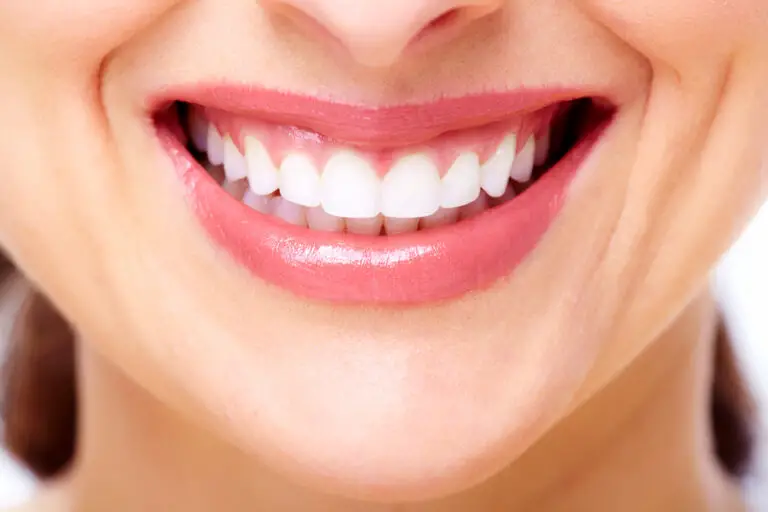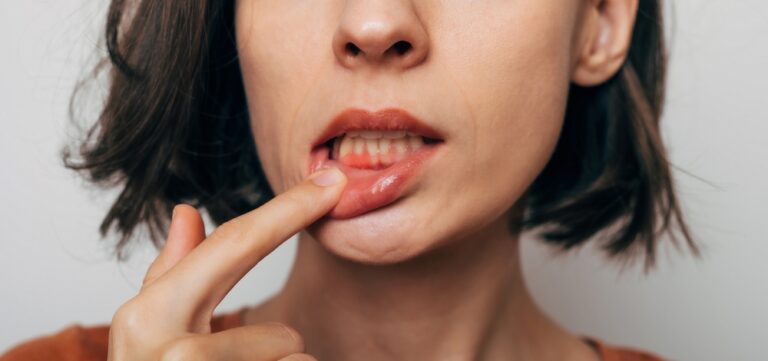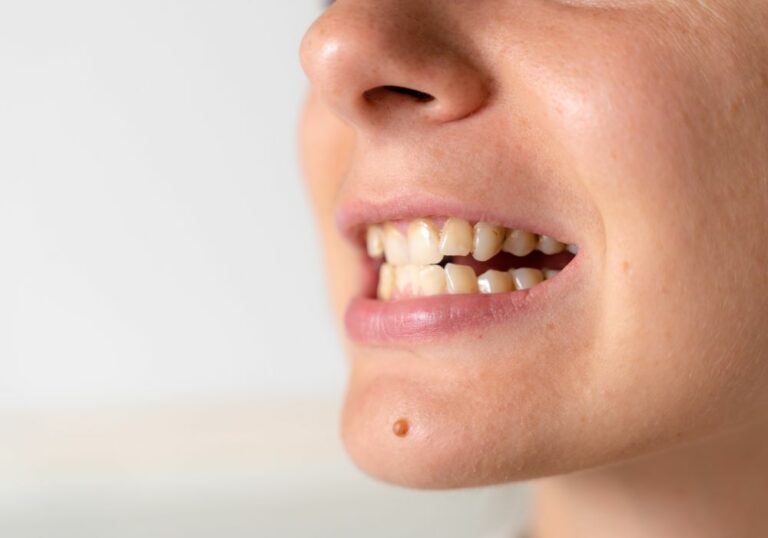Xylitol gum has become very popular in recent years as a sugar-free alternative to regular chewing gum. There have been some claims made that xylitol gum can actually help whiten and improve the appearance of teeth. In this comprehensive article, we will analyze in detail the evidence surrounding xylitol gum and its potential effects on teeth whitening.
What Exactly is Xylitol?
Before examining how xylitol may interact with teeth, it’s important to understand exactly what xylitol is.
Xylitol is a natural sugar alcohol that is used as a sweetener in many products, including sugar-free gums, candies, toothpaste, and more. Chemically speaking, xylitol contains 5 carbon atoms and 5 hydroxyl groups, giving it a very similar sweetness to table sugar but with 40% fewer calories.
In nature, small amounts of xylitol can be found in certain fruits and vegetables like plums, strawberries, cauliflower, and mushrooms. However, for commercial products, xylitol is most often extracted from birch tree bark or derived from xylan in corn cob fibers.
Compared to regular white granulated sugar, xylitol has been shown to have potential dental health benefits:
- Does not promote tooth decay – The bacteria in our mouths that cause cavities like Streptococcus mutans cannot efficiently use xylitol to grow and produce acids that erode tooth enamel. This means that xylitol does not lower pH levels in the mouth nor provide food for bacteria like sucrose and glucose sugars. Therefore, xylitol does not directly contribute to demineralization and tooth decay.
- Inhibits growth of cavity-causing bacteria – Studies have shown that xylitol can actively prevent streptococcus mutans bacteria from adhering to the surface of teeth. Xylitol can also reduce the amount of S. mutans found in saliva by as much as 90% during use. With less S. mutans, the mouth becomes less hospitable for tooth decay.
- Increases saliva production – When ingested orally, xylitol stimulates saliva flow. This is also true when xylitol is used in chewing gum. More saliva production helps to neutralize acidity in the mouth and wash away food debris after meals and snacks before it can become plaque on tooth surfaces.
These unique effects made xylitol a very useful and popular sugar substitute, especially in chewing gums, mints, mouthwashes and toothpaste. Products containing xylitol can help prevent cavities while still offering the sweet taste that consumers crave. But what does the evidence say regarding xylitol’s effects on tooth whitening and aesthetics?
Can Xylitol Directly Whiten Teeth?
There is limited clinical evidence showing that xylitol can directly whiten or bleach teeth the way other chemicals like hydrogen peroxide or carbamide peroxide can. No studies have conclusively proven that simply chewing xylitol gum or using xylitol toothpaste leads to dramatically whiter teeth or brighter smiles.
However, research has shown that xylitol can have some indirect whitening effects on teeth over time when used consistently:
- Prevents new stains – By inhibiting cavity-causing S. mutans bacteria and reducing plaque on teeth, xylitol helps limit new stains from forming on enamel from sugary or acidic foods and drinks. Less bacteria and plaque means less tooth discoloration.
- Reduces tooth decay – Tooth decay from cavities and dental caries can cause unsightly yellowing or dark brown spots and marks on affected teeth. By reducing cavities, xylitol may help teeth maintain a whiter, cleaner appearance.
- Promotes remineralization – Xylitol draws calcium ions into saliva and onto enamel, helping to actively repair early decay and remineralize demineralized areas on teeth. This provides a smoother, whiter tooth surface.
- Increases saliva flow – The extra wash of saliva produced when consuming xylitol helps to carry away staining particles from food and drinks before they set on tooth enamel and cause discoloration.
So while xylitol gum and xylitol toothpaste will not brighten or “bleach” teeth to a dramatically whiter shade, they can certainly help maintain whiter teeth by actively preventing stains and tooth decay in the first place.
How Does Chewing Xylitol Gum Benefit Your Teeth?
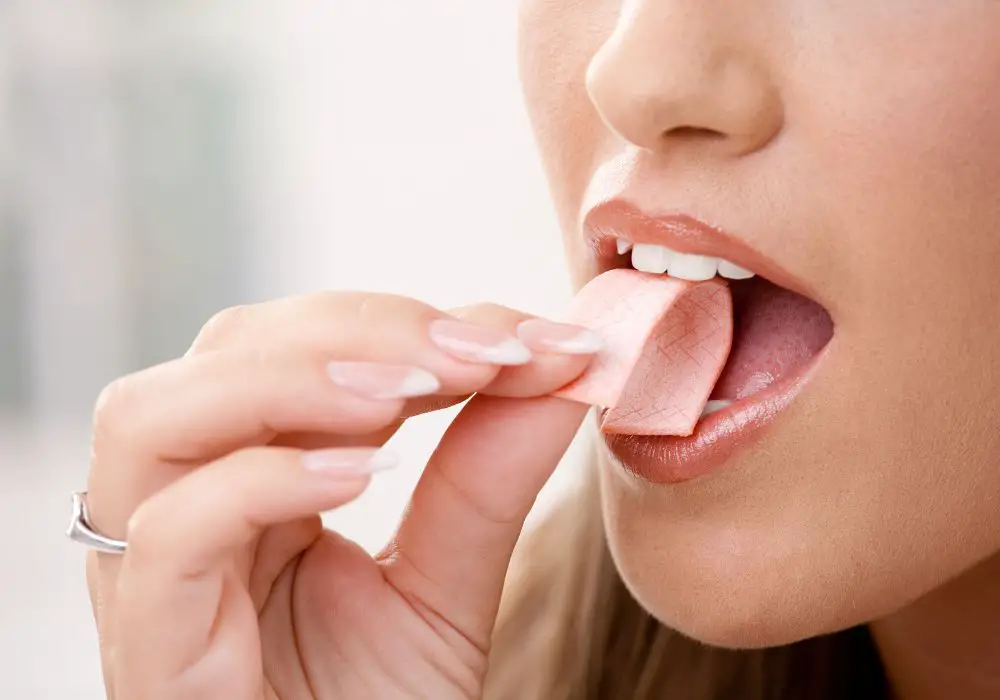
Chewing gum that has been sweetened with xylitol provides an ideal delivery method for getting the benefits of xylitol to your teeth, gums, tongue and other areas. Here is how chewing xylitol gum in particular may benefit your dental health and appearance:
- Direct contact – While you chew gum, the xylitol in the gum base and coating directly contacts your teeth and coats tooth surfaces. This allows xylitol to draw out and dilute damaging acids from foods and drinks.
- Stimulates saliva – Chewing gum has been shown to increase saliva production up to 10 times the normal rate compared to resting flow. This extra saliva washes away food debris and helps neutralize plaque acids.
- Sustained release – Unlike candy or toothpaste, gum continues to release some xylitol into the mouth for minutes or longer during chewing. This provides a sustained bacteria-fighting effect.
- Convenient delivery – Chewing gum makes it very convenient to frequently expose your teeth to xylitol throughout the day. More consistent xylitol exposure maximizes the potential benefits for tooth health.
- Gum chewing effects – Chewing gum flexes jaws, stimulates circulation and cleans teeth surfaces through abrasion and friction. This mechanical cleaning enhances xylitol’s effects.
For these reasons, xylitol gum is likely more effective at delivering oral health and whitening prevention benefits than other vehicles like hard candies or even toothpaste, which stays on teeth for mere seconds or minutes at a time. For maximum effects, look for gum with xylitol listed as the first ingredient.
What Are the Optimal Xylitol Gum Chewing Habits?
To gain the most benefits for your dental and oral health, xylitol gum should be chewed in the right way. Follow these best practices based on research:
- Chew xylitol gum for at least 5 minutes at a time, preferably longer for 10-20 minutes of active chewing. Short chewing times limits the amount of xylitol that contacts teeth and the extent of extra saliva production.
- Chew xylitol gum after meals or snacks when your mouth will benefit most from extra saliva to wash away food acids and debris. Try to chew within 5-10 minutes after eating.
- Allow the gum to come into contact with all tooth and gum surfaces by chewing first on one side, then the other. Move it across upper and lower teeth.
- Look for gums that contain at least 1 gram of xylitol per piece. Smaller amounts may not offer the same magnitude of benefits.
- Rotate usage of xylitol mints and candies during the day for extra xylitol exposures in addition to gum.
With smart xylitol gum chewing habits, gum can provide regular preventive benefits against tooth decay, promote remineralization, and inhibit bacteria – all of which help to maintain or improve tooth appearance.
Potential Side Effects of Xylitol
Xylitol gum is generally very well tolerated, but some people may experience minor side effects like:
- Gas or bloating – For some users, consuming excess xylitol can initially cause some intestinal discomfort and flatulence when bacteria in the gut ferment the xylitol. This often improves with gradual exposure as the digestive system adapts.
- Diarrhea – Very high single doses of xylitol above 30-40 grams at once can draw water into the intestine through osmosis and lead to temporary, mild diarrhea. This reaction is unlikely with xylitol gum usage, as gum typically contains less than 1 gram per piece.
- Allergic reactions – Xylitol, like any substance, can possibly cause allergies in a small number of people predisposed to sensitivities. Symptoms may include hives, runny nose, or skin rash. Discontinue use if any concerning allergic reaction emerges.
When first introducing xylitol gum, start with moderation and gradually increase daily exposures to monitor for potential digestive side effects. For some, other sugar alcohols like sorbitol may be better tolerated if xylitol causes significant gas or diarrhea.
Additional Teeth Whitening Benefits of Chewing Xylitol Gum

Aside from xylitol’s core benefits of inhibiting S. mutans cavity bacteria, neutralizing plaque acids and promoting remineralization, chewing xylitol gum provides some supplemental advantages that can enhance teeth whitening over time:
1. Prevents dry mouth – Xylitol gum boosts saliva production, which keeps the mouth moist. Chronic dry mouth allows more bad bacteria to grow and promotes increased dental plaque acidity that causes decay and yellowing.
2. Cleans the mouth – The physical act of chewing gum can help clean the teeth, gums, tongue and other soft tissues. This mechanical cleaning effect helps dislodge food particles and sweep away staining compounds.
3. Freshens breath – Xylitol inhibits odor-causing bacteria in the mouth, throat and tonsils that cause bad breath. The saliva increase also helps dilute odors. Fresher breath improves mouth aesthetics.
4. May reduce erosion – Acids from acidic drinks and foods can erode enamel over time, allowing dentin to become exposed which appears yellow. Xylitol gum after meals protects teeth by stimulating buffering saliva flow.
While small, these supplementary advantages can enhance the teeth whitening prevention effects of consistent xylitol gum usage over months and years. Using xylitol mouthwashes and toothpaste provides further protection against tooth decay and discoloration between gum chewing.
Reviewing the Clinical Research on Xylitol Gum
Many clinical studies have investigated the effects of xylitol gum chewing on oral health parameters:
- In a 2-year trial, subjects were asked to chew xylitol gum 3 times per day vs. no gum. The xylitol group had significantly less dental plaque and 50% fewer cavities compared to the control group not using gum.
- In high cavity-risk children, consistently using xylitol gum led to a dramatic 58% reduction in tooth decay versus children not chewing gum over a 2 year follow-up period.
- A 6-month trial had subjects randomized to either 100% xylitol gum or gum containing 70% xylitol + 30% sorbitol. The 100% xylitol gum group had a notable reduction in gingivitis and plaque accumulation compared to the xylitol-sorbitol blend group.
- In patients with gingivitis, one study found that chewing xylitol gum after initial periodontal therapy reduced bleeding and inflammation of the gums compared to no gum use. The xylitol helped pockets stabilize.
- Multiple trials in children have found that using xylitol gum led to impressive decreases in salivary S. mutans bacteria levels compared to control groups not chewing gum. Lower decay rates followed over the next 1-2 years.
While no studies directly analyzed whitening, one can infer that the observed reductions in plaque, tooth decay, gingivitis and bacteria when using xylitol gum would likely translate to meaningful improvements in tooth color, from preventing new stains and decay. However, more direct research is still needed.
Are There Better Alternatives for Whitening Teeth?
While xylitol gum provides unique oral health benefits and can support whiter teeth over time, there are likely more effective options available if whitening teeth is your primary goal:
Whitening Toothpaste – Today’s whitening toothpastes contain mild abrasives that physically scrub away stains through friction, often with added chemicals like hydrogen peroxide that chemically lighten tooth shade. Using a whitening toothpaste 2-3x per day can produce noticeable whitening results over a few weeks.
Whitening Strips – Plastic whitening strips coated with peroxide can be applied to teeth and have been clinically shown to safely bleach teeth multiple shades whiter through 1-2 weeks of consistent use. Some sensitivity or gum irritation may occur.
In-Office Bleaching – Dentist-performed in-office bleaching uses higher concentrations of hydrogen peroxide gels or laser lights to dramatically whiten teeth by several shades in a single 60-90 minute visit. Provides maximal results, but can be expensive. Needs occasional touch-ups.
Dental Cleanings – Having professional cleanings and plaque removal at the dentist every 6 months reduces tooth stains for a whiter smile and prevents gum disease. Be sure to get your routine dental check-ups!
For the greatest cosmetic whitening effect, combining preventive xylitol gum usage with one or more of the above aggressive whitening modalities can optimize results by actively preventing new stains while also bleaching away existing discoloration for whiter teeth.
The Bottom Line: Can Xylitol Gum Whiten Your Teeth?
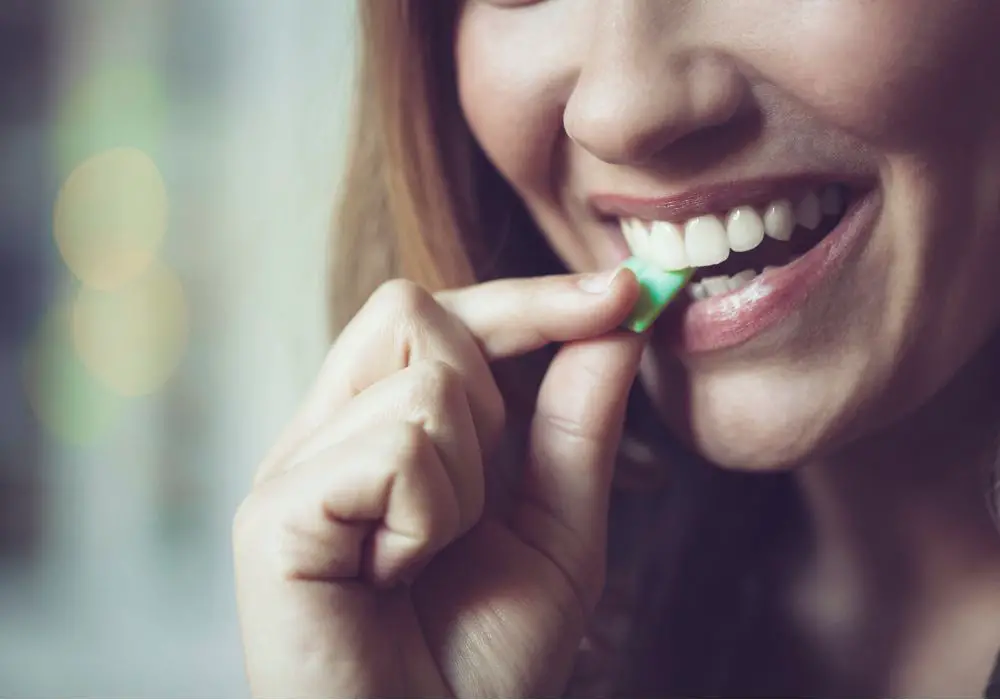
Here is a summary of the key points surrounding xylitol gum and its effects on teeth whitening:
- Xylitol gum does not contain bleaching agents, so it does not actively whiten or bleach teeth to become dramatically whiter. But it provides some indirect whitening benefits over time.
- By preventing new cavities and slowing tooth decay, consistent xylitol gum usage helps reduce yellowing and stained spots on teeth caused by decay bacteria.
- Chewing xylitol gum boosts protective saliva flow that helps wash away staining compounds from food, drinks and smoking before they adhere to enamel.
- To see notable whitening prevention benefits, xylitol gum must be chewed for 5-10 minutes at least 2-3 times daily long-term. Proper gum chewing habits are critical.
- For significant cosmetic tooth whitening, xylitol gum works best paired with other professional or over-the-counter whitening treatments that bleach teeth.
While not a miracle solution on its own, chewing xylitol gum can be a beneficial supplement for maintaining or achieving whiter teeth when paired with thorough oral hygiene practices and occasional bleaching treatments as needed.
Frequently Asked Questions
1. How much xylitol gum should be chewed per day for oral health and whitening benefits?
For preventive dental health and whitening benefits, current research suggests chewing xylitol gum for at least 5-10 minutes at a time, 2-3 times per day. Ideally, each piece of gum should contain at least 1 gram of xylitol in the ingredients – more is even better. The American Dental Association (ADA) states than 3-5 g of xylitol divided throughout the day is optimal, and that as little as 2-3 g may provide meaningful benefits. As long as stomach tolerance permits, more frequent xylitol exposures from gum can provide increased oral health advantages.
2. What are signs that chewing xylitol gum is actively preventing stains and decay?
Dramatic cosmetic whitening is unlikely with xylitol gum alone. However, subtler positive signs it is working include: no new cavities forming at dental checkups, visibly less dental plaque on teeth, improved gum health and reduced inflammation, and no major progression in tooth staining/discoloration or enamel weakening. Prevented progression of tooth decay may also be apparent.
3. Can regular gum work as well as xylitol gum for whitening effects?
For teeth whitening purposes, regular sugar-containing gum is not likely to be as beneficial as xylitol-sweetened gum. The sugars in regular gum like sucrose and corn syrup can feed acid-producing oral bacteria, potentially worsening decay and staining. Non-xylitol gum also does not stimulate saliva production to the same degree as xylitol gum. However, chewing any gum may confer some general oral cleansing effects compared to not chewing gum.
4. How soon after eating or drinking should I chew xylitol gum?
To gain the most tooth protection, it is ideal to chew xylitol gum within 5-10 minutes after consuming stain-promoting foods and drinks. This allows the gum-stimulated saliva production to quickly neutralize acids and wash away staining compounds from the mouth before they have time to set and adhere to tooth surfaces and cause discoloration. The sooner you can chew xylitol gum after eating or drinking, the better.
5. Is xylitol gum safe to use during pregnancy?
Yes, chewing moderate amounts of xylitol gum should be safe for your oral health during pregnancy according to most dentists. However, be sure to check with your OB-GYN doctor as well, as they may recommend limiting total xylitol intake during pregnancy to avoid excessive gas or diarrhea side effects. Look for gum where xylitol is the only sugar alcohol sweetener, and with no sorbitol, mannitol or other additives. Maintaining excellent nutrition and dental hygiene practices remains critical during pregnancy.

